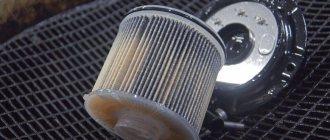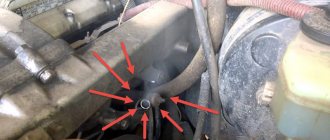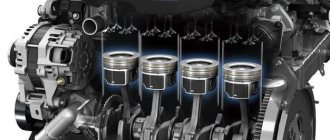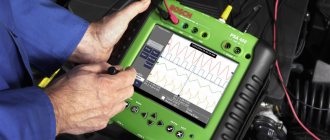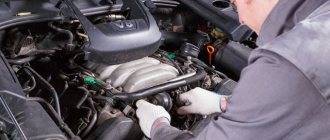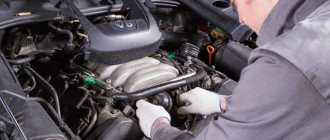Let's start with the fact that over the past ten years, the diesel engine in passenger cars has become a worthy alternative to gasoline counterparts for a number of reasons. At the same time, among the main advantages is significant fuel economy due to better efficiency and other positive qualities of engines of this type.
However, this type of engine is also not without its drawbacks. The main problem of all diesel engines in modern cars without exception is the vulnerability of the sensitive fuel system, as well as the difficulty of cold starting. It should be noted that certain knowledge allows you to avoid a number of similar troubles during the operation of a diesel engine.
In this article we will talk about what a novice diesel driver needs to know about the features of engines of this type, as well as how to start a diesel engine in cold weather and do it correctly with minimal damage to the internal combustion engine and other powertrain systems.
Winter starting a diesel engine: how to properly start a diesel engine in cold weather
Let's start with the fact that over the past ten years, the diesel engine in passenger cars has become a worthy alternative to gasoline counterparts for a number of reasons. At the same time, among the main advantages is significant fuel economy due to better efficiency and other positive qualities of engines of this type.
In this article we will talk about what a novice diesel driver needs to know about the features of engines of this type, as well as how to start a diesel engine in cold weather and do it correctly with minimal damage to the internal combustion engine and other powertrain systems.
Cold start of a diesel engine in winter: difficulties and nuances
As a rule, problems with diesel engines begin precisely when the outside air temperature drops to zero or below. At near-zero and subzero temperatures in any engine, the engine oil thickens somewhat, the fuel evaporates worse, the battery discharges more strongly, etc. As a result, launching may naturally become more difficult.
It turns out that in the summer, gas stations sell so-called “summer” diesel fuel, while to solve the problem of the onset of cold weather, “winter” diesel fuel is supplied to gas stations. To put it simply, special additives are added separately to summer diesel fuel, which allow this type of fuel to remain fluid even at sub-zero temperatures.
It is important to understand that in the off-season, when it is still relatively warm during the day and cold at night, not all gas stations have time to switch to winter diesel in a timely manner. If we take into account that winter fuel itself is also more expensive, then some unscrupulous sellers, in pursuit of profit, quite often sell summer diesel fuel at the price of winter before the onset of stable cold weather. The situation is further complicated by the fact that visually, by smell, consistency and any other signs, it is impossible to distinguish summer diesel fuel from winter diesel fuel.
How to start a diesel engine correctly in winter
So, we sorted out the “fuel” risks. Now it becomes clear that a common problem when starting a diesel engine in winter, which leads to difficulties during a cold start, is unsuitable for the season or low-quality diesel fuel. The following solutions are surefire ways to avoid such problems:
If everything is clear with the first two methods, then the third solution is questioned by many engine repair specialists and experienced car enthusiasts. The fact is that adding various third-party additives to the fuel tank can be unsafe for the diesel power system and the internal combustion engine itself.
Let's go back to the cold start. Let's imagine a typical situation when there is no garage, and the car itself has been standing on the street for quite a long time. At the same time, the car is not additionally equipped with any heating. In this case, you need to know how to start a diesel engine in winter and what you need to do to do everything correctly.
First of all, it is taken into account that starting a diesel engine in winter compared to a gasoline engine may be more difficult due to the individual differences of such an engine. More precisely, fuel injection and further ignition of the fuel and air mixture in a diesel engine occurs somewhat differently than in a gasoline internal combustion engine.
Service
The specifics of operating diesel engines imply scrupulous compliance with all manufacturer's requirements, any violation of which may ultimately lead to the need for expensive repairs. Recommendations common to all power plants of this type include:
- Timely replacement and quality control of oil. Experts advise carrying out this procedure even more often than the service interval prescribed in the manual. This recommendation is due to the unstable sulfur characteristics of Russian diesel fuel. As a conditional interval, you can focus on a mileage of 7000 km? 7500 km.
- Timely replacement of the timing belt. In this case, it is recommended to follow the same principle as when changing the oil. For many engines, the permissible belt mileage reaches 100,000 km, but it must be taken into account that we are talking about practically sterile conditions, which are fundamentally unattainable on domestic roads. The breakage of a belt that has worn out prematurely always means destruction of the cylinder head, the repair or replacement of which costs a significant amount.
- Monitoring the cleanliness of the fuel system. It is recommended to replace the filter at least every 10,000 km, and to regularly drain the sediment that accumulates in the sump from the filter itself. It is advisable to wash the fuel tank twice a year, removing it from the car. Failure to comply with these requirements may result in failure of the injectors and fuel pump.
What to do if the diesel engine does not start
If the power unit worked normally, but after a cold spell it did not start even after warming up with spark plugs, then you should check the glow plugs themselves, the condition of the fuel, as well as the air and fuel filters.
In some cases, it turns out that glow plugs require replacement. Also, if the air filter is dirty, there may not be enough air, and thickening of the fuel or contamination of the fuel filter leads to a lack of fuel.
By the way, on engines with high mileage, failure to start may indicate a decrease in compression due to general wear of the CPG. In this case, the engine must be disassembled, defective and repaired.
How to choose a suitable glow plug control unit?
Since glow plugs and glow plug control units are not universal, it is important to select the correct ones for your vehicle and fuel. In addition, it is recommended to use the best quality components, as poor quality parts can lead to costly repairs later. For example, a swollen glow plug made from poor quality materials may be impossible to remove or the tip may break off inside the cylinder and damage the cylinder, valve and head.
Tips and tricks
Some experienced drivers use the following method to make starting a diesel engine easier in winter:
Let us immediately note that this decision is an emergency measure, that is, this method cannot be used regularly. Starting with gasoline vapors leads to increased loads, which significantly reduces engine life.
It is also recommended to insulate the engine compartment and engine separately. A car blanket is well suited for this, as it retains heat and prevents the internal combustion engine from cooling quickly. It would also be a good idea to insulate the radiator of the cooling system. For these purposes, you can use various solutions, the simplest of which is to install a thick cardboard “damper”.
Finally, we note that it is not recommended to warm up a diesel engine for a long time at idle, since this type of engine warms up only when driving under load. This means that after 3-5 minutes of starting work, you need to drive a diesel car, but drive for the first 5 km. should be smooth, without a significant increase in speed, sudden starts and braking, driving in high gears, etc.
Available ways to independently check the glow plugs of a diesel engine. Diagnostics of glow plugs with removal, checking with a tester for spark.
Why is it better to warm up the engine before driving: lubrication, fuel, wear of cold parts. How to properly warm up a diesel engine in winter.
Features of the choice of Webasto and Hydronic preheaters. Characteristics, installation and cost, warranty. Which heater is better?
What is Webasto? Operating principle of autonomous pre-heaters. Pros and cons of a liquid heater and an air heater (hair dryer).
Warming up the engine oil before starting: why is it needed? Available methods of heating oil, what you need to know. Oil pre-heater in the sump.
The main reasons for difficulty starting a hot diesel engine. Problems with the injection pump plunger pair, fuel overflow through diesel injectors, sensors.
Source
Riding Features
Warming up and stopping the engine. The issue of cold driving is debatable. The operation of diesel engines allows this possibility, however, it should be taken into account that the thermal clearances at this moment are increased, and the cooled oil, on the contrary, partially loses its lubricating properties, which in combination leads to increased wear of parts. The optimal solution would be to drive at speeds up to 40 km/h with 3rd or 2nd gear engaged. You can turn off a non-turbocharged engine immediately, but a motor equipped with a supercharging system must be given the opportunity to run without load so that the bearings have time to cool and are not covered with a varnish film.
Optimal speed. Power units of this type are low-speed. The habit of “spinning” the engine above 3,500 rpm - 4,000 rpm leads to accelerated wear of the cylinder-piston group and crank mechanism. The optimal range for such engines is, depending on the model, the range from 1600 rpm to 3200 rpm.
Air filter specifics. Diesel units are not equipped with inlet throttling, which, combined with the small volume of the combustion chamber and high suction properties, provokes a water hammer when even a minimal amount of water enters the filter.
Refusal to start with traction. A correctly operating power unit starts normally at an ambient temperature of up to?20°C. If starting is difficult, it is strictly forbidden to try to “pull” the car, as this may damage the timing drive. In addition, a mismatch between the temperature tolerance of the fuel and the temperature outside leads to crystallization of paraffin and the loss of the required fluidity of the fuel. In this case, an attempt to start the engine while in tow will result in dry friction and damage to parts of the power unit.
Why is it difficult to start a diesel engine after a long stay in winter?
There can be many reasons for difficulty starting the engine at sub-zero temperatures. But they all have a common denominator - liquid. The colder it is outside, the harder it is for the engine to work. This applies most of all to cars running on diesel fuel (diesel fuel).
As the ambient temperature drops, diesel fuel begins to thicken . As a result, this leads to a change in composition. This usually leads to problems. Therefore, diesel fuel is divided into winter and summer. In cold weather, summer fruit tends to thicken and become waxy.
Thick diesel fuel cannot be pumped through the power system. To prevent this from happening, additives are added in the summer to prevent thickening at subzero temperatures. Those. In winter, gas stations sell diesel fuel that already contains additives. That’s why it’s called “winter”.
In addition, the battery also contains liquid. In cold weather, current generation is more difficult.
The cause of difficulty starting a diesel engine may be engine oil. It also thickens in cold weather.
To make it easier to start the engine and to ensure that it experiences minimal stress when driving in winter, read the article - choosing diesel oil.
Refueling
One of the features of operating diesel engines of any type is meticulous attention to fuel quality. Experts advise checking even fuel from branded gas stations yourself.
The main enemy of a diesel installation is the presence of water in the mixture, which can provoke corrosion in the fuel equipment. To avoid this, it is recommended not to fill the fuel directly into the tank, but to put it in cans and let it settle so that possible sediment and impurities have time to sink to the bottom.
A simple way to check the mixture for the presence of water is to add potassium permanganate crystals to a test portion collected in a transparent container. If there is water around them, colored stains immediately form.
Another important criterion is the absolute transparency of the mixture. Any cloudiness, especially in winter, may indicate the initial stage of crystallization of paraffin, which easily clogs fuel filters.
How to start a diesel engine after sitting in cold weather?
Don’t panic right away if you were unable to start your car’s engine in the cold morning. If you turn the ignition key the first time and the engine does not start, wait a minute or two and repeat again. Ideally, the engine will start on the 3rd attempt maximum. If the 3rd has occurred, do not continue to start it under any circumstances, as you will significantly aggravate the situation. The starter may fail or the battery may be discharged.
Starting a diesel engine in winter is practically no different from a gasoline engine, but there are some nuances :
Warming up the spark plugs
Before starting a diesel engine in winter, you need to warm up the spark plugs . But how to do it correctly?
As a result of this procedure, the spark plugs will warm up, this will be enough to guarantee starting the engine, provided that the battery is charged, the fuel is not frozen, and the spark plugs are in good condition.
If you fail to start a diesel engine in winter, you should use the methods described below.
Starting the engine by “lighting”
If your car's battery was weak and died in the cold. In such a situation, it is enough to ask for help from friends, acquaintances, or a neighbor in the parking lot that they have “lit up.” The procedure does not take much time, the main thing is that there are wires.
Owners of diesel cars - make sure that you always have cables in the trunk.
If you managed to start the diesel engine using this method, then you can go about your business in peace. But remember that you should not turn off the engine immediately after starting, because... The battery needs to be recharged , and for this you need to drive at least a couple of kilometers. But it is better if the engine runs for at least 30 minutes.
What to do if diesel fuel is frozen?
How to start a diesel car in winter if the fuel is frozen? with diesel fuel containing a huge amount of paraffin . All that remains is to drain the diesel fuel and heat it to a temperature of 60 degrees, add an additive or anti-gel, mix and pour it back into the tank.
Add kerosene
Motorists who have impressive driving experience behind them prefer to add kerosene instead of additives. Essentially the effect is the same. In addition, it does not cause any harm to the fuel or the fuel system. It makes diesel fuel more liquid.
If you decide to add kerosene, then follow the proportions. Thus, for 100 liters of fuel, 30 liters of kerosene, no more.
Never add gasoline to diesel fuel. A serious mistake and misconception of many car owners. Gasoline does not have lubricating properties, unlike additives and kerosene. As a result, the car’s high-pressure fuel pump will pump diesel fuel “dry,” which can lead to breakdown. And this is not small money.
Why is overheating possible?
Another possibility for the turbocharger to heat up greatly is driving in difficult conditions: off-road, etc. In this case, the engine will not develop maximum power, since the wheels will slip. However, the absence of oncoming air flow contributes to an increase in the temperature of the engine, and at the same time the turbocharger. Overheating is also possible when driving in the mountains with a lot of climbs, as well as with a trailer.
But the peak of trouble comes not during work, but afterwards! After stopping the engine, the cooling of the hot turbocharger deteriorates sharply. Oil is no longer supplied, heat goes into the bearing assembly, and the remaining lubricant in the bearing and its seals begins to coke. Over time, this leads to deterioration of the seal and disruption of the design operating mode of the bearing. And rotation of the rotor without supplying oil under pressure provokes the appearance of scuffing.
The liquid cooling systems of the turbocharger also stopped working after the engine was stopped and, accordingly, did not remove heat from the supercharging unit. That is why there were recommendations not to turn off the engines immediately, but to let them run for some time at minimum idle speed. At the same time, the oil and coolant will circulate, the temperature of the exhaust gases entering the turbine part will drop - as a result, the turbocharger cools down, and then the engine can be safely turned off.
Turbo timer and circulation pumps
Turbo timers are not routinely installed even on cars with charged engines. And not because the problem has disappeared somewhere - nothing has fundamentally changed in the internal combustion engine. Yes, designs, materials and lubricants have changed and become more advanced, but turbochargers still do not like overheating. Maybe automakers use other means of protecting turbochargers from overheating?
Some companies (in particular, Porsche, Volkswagen, Skoda, Jaguar) install electric circulation pumps on many turbocharged models, which, if necessary, supply coolant to the turbocharger. Even after stopping the engine, antifreeze circulates through the unit for some time, preventing it from overheating. Reminiscent of a similar mode of operation of electric cooling system fans, implemented on most modern cars. The motor is turned off, but the fan continues to spin. It is clear that in this case there is no need for a turbo timer.
Many automakers shift the function of the intelligent turbo timer to the driver! Most instructions note that after operating the car in conditions close to the maximum permissible, it is recommended to let it run without load for several minutes before turning off the engine. That is, the advice remains the same as it was decades ago.
Last year, out of the 25 best-selling models in Russia, five were equipped with turbochargers. At the same time, an additional electric pump that cools the turbocharger is used in three models: Skoda Kodiaq, Skoda Octavia A7 and VW Tiguan. It turns out that most manufacturers of relatively affordable cars do not bother with such problems. The logic is simple: there is no increase in price, and the car is most likely out of warranty anyway. What next is the owner's concern.
Do not turn off the engine immediately - let it run at minimum speed. The operating conditions of a turbocharger are very difficult, and no innovations have appeared that would make it immortal.
Faulty injection pump and injectors
If the pump breaks down, it is impossible to create the required pressure in the fuel system. If there is a partial malfunction, the diesel engine will “sneeze.” But there is another important point here. As a rule, most injection pump designs have a belt drive. This is what needs to be checked initially. The belt may fall off or break.
The second point is the pump fuses, which can blow out, for example, due to unsuccessful (unprofessional) repairs. In such cases, diesel is bad.
injection pump
Our recommendations
We have a different opinion. The operating conditions of a turbocharger are very difficult, and fundamental innovations that make it immortal have not yet appeared. In addition, this is not a cheap unit: repairs will hit your pocket when the warranty ends. And if your car is not equipped with an electric pump that pumps coolant after stopping, we strongly recommend pausing for one or two minutes before turning off the engine, which has worked at the limit. However, how can you tell whether your car has such a pump or not? For example, by ear: after an intense ride, stop the engine and listen for a characteristic buzzing sound. But it's better to play it safe, even if the automaker says there won't be any problems.
Alternative commentary from a specialist
In 11 years of working at the test site, I have never encountered a car with a turbocharged engine that was equipped with a turbo timer as standard. Apparently, manufacturers believe that with normal operation, the use of high-quality lubricants and fuel, as well as with correct and timely maintenance and repairs, there will be no problems with the turbocharger.
The supercharging unit has a sufficient resource, and its cooling from operating and design temperatures will occur due to inertia. The heat resistance reserve of the materials used is also sufficient.
Did you like this post? Subscribe and you will always be in the know!
Source
December 19, 2022 Category: Useful information.
We have already written about how to make it easier to start a diesel engine in cold weather.
Today we’ll talk about the mistakes that owners make when starting a diesel engine in winter. These errors reduce the life of the unit and can lead to serious and expensive breakdowns. But cold starting is already a difficult test for a diesel engine.
Repair Tips
Trying to save money on spare parts or maintenance when operating a diesel engine can lead to the need for expensive repairs. Due to significant loads, strict requirements are imposed on the quality of components of this type of power plants.
Using cheap spark plugs, chains and other components can turn into a pointless waste of money, as the parts will fail in no time.
A similar principle is relevant for the service itself, where repair work is carried out. Hiring unqualified mechanics can result in lost time, money, and even further damage to the engine.
Repairing diesel engines requires strict adherence to work regulations and the availability of professional knowledge and equipment for the performers.
Modern diesel engines have proven themselves on the positive side, however, the complex design and demanding nature of such models require qualified service.
Diesel is a representative of the largest brands of automotive components, and also offers services for adjustment and repair of fuel equipment of domestic and foreign production. You can select the right diesel engine, as well as view the characteristics and photos of the products in the catalog on the company’s website.
error: straight to the point
Many car owners do not hold the ignition key in the “ON” position and, skipping the stage of scanning all car systems with the on-board computer, start the starter as quickly as possible. In cold weather, this mistake can be costly.
You can start a diesel engine (in general, but especially in winter) only after 3-5 seconds after turning the key to the “ON” position, all the “extra” indicators have gone out and some fuel has been drawn into the pump. Then you can start the engine.
error: glow plugs do not heat
Ideally, you need to activate the glow plugs three times in this way: turn the key to the “ON” position, wait until the glow plug indicator goes out, wait for a characteristic click, repeat. After the third such stage, you don’t have to wait for the relay to click, but simply start the diesel engine. As a result, you will spend a little more time starting, but you will ensure a trouble-free engine start, and the fuel in the heated chamber will ignite more accurately and efficiently.
error: clutch not released
It is useful for the owner of a car with a manual transmission to develop the habit of depressing the clutch when starting the engine in cold weather. This is due to the way the engine starts. When you turn the key, the battery transmits the necessary voltage to the starter so that it can turn the crankshaft and the input shaft in the gearbox.
When the driver depresses the clutch pedal, disconnecting the gearbox and engine, the starter can only crank the crankshaft. While when starting the engine with the clutch engaged, it is also forced to turn the gears and transmission shafts in oil thickened in the cold. This increases the chances of starting the engine even with a dead battery.
error: “wake up” the battery
Advice from USSR car owners: before starting the engine, “load” the battery by blinking the headlights for 20-30 seconds to force the battery to deliver starting current more efficiently.
Such advice has the right to life only if the battery is in good condition and not discharged, and the car is stored at night in a warm garage. Then yes, “blinking” the high beams will cause the battery to pass current, the electrolyte temperature will increase, and the actual battery capacity will increase.
That is, when starting an internal combustion engine “cold” with a questionable charge level, it is important to turn off all battery energy absorbers, be it a stove, radio or headlights. Otherwise, you may simply not start the engine. And even if the battery capacity is enough to start the engine, the voltage on the on-board network may drop so much that the alarm system or central locking in the car, for example, will stop working.
There are no other secrets to “waking up” the battery.
mistake: they abuse diesel fuel additives
Diesel engine additives can only be used on older engines and only if the quality of the “winter” diesel fuel raises questions.
At the same time, they must be added strictly according to the instructions, in warm fuel and on the eve of cold weather. And if you pour “antigel” into a tank with cold diesel fuel, it will generally curl into jelly and the entire fuel system of the diesel engine will become clogged with paraffin flakes.
error: starter fires
If you fail to start the engine, you can hitch a ride after 30-40 seconds. But the number of attempts should not exceed 4-5 times.
error: using “quick start” tools
In fact, by injecting aerosol ether through an air duct or filter, you are trying to ignite the fuel mixture under low compression conditions. As a result, the engine may receive a pneumatic shock, resulting in damage to the timing elements and the intake system. And in a diesel engine, when using “quick start” products, there is a risk of fire if the product gets on the heated glow plugs.
What absolutely should not be done
Some drivers consider starting a sleeping engine by towing. We do not recommend doing this as it is very risky. With such a start, the acceleration angle of the rotating flywheel will be greater than with a normal start using a starter.
In modern passenger cars, the timing belt drive will jump forward after several teeth or simply break. If the timing chain is made of metal, it can stretch. Be that as it may, when starting the engine by towing, there is a great possibility of disrupting the correct arrangement of the elements of the gas distribution mechanism, pistons and cylinders. Repairing pistons and valves can cost you a fortune later on.
Advice: if towing is the only and inevitable option, then engage a higher gear, third or fourth. In this case, at least to some extent, increased shock loads on timing parts can be avoided.
